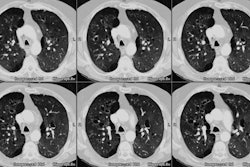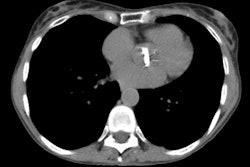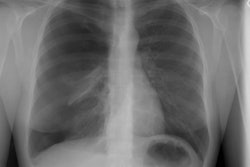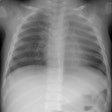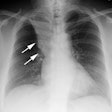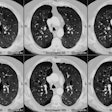Lung Hernia:
View cases of lung hernia
Clinical:
A lung hernia is defined as a protrusion of the lung parenchyma beyond the confines of the thorax- the lesion can be acquired or congenital.
Congenital Lung Hernia: About 20% of lung hernias are considered to be congenital in origin. The most common location (60%) is at the thoracic inlet (cervical) where there is a potential space between the anterior scalene and the sternocleidomastoid muscles. This area is normally covered by Sibson's fascia (a continuation of the endothoracic fascia over the apex of the lung), however, a absence or laxity in this fasica can allow a herniation to occur. Most cases are identified during infantcy when herniation of the lung apex into the supraclavicular fossa and soft tissues of the neck coincides with elevation of the intrathoracic pressure (as seen during crying). Most infants are asymptomatic and the hernia will generally spontaneously reduce after the first year of life. Occasionally, cervical lung hernias may cause symptoms due to airway compression. Incarceration with ischemia is rare. Radiographically apical hernias appear as radiolucencies which extend into the base of the neck. They frequently cause lateral deviation of the trachea. Hernias may only be evident with Valsalva or maximal inspiration and fluoroscopy may be required to conform their presence. Another congenital site for lung herniation is the chest wall due to anomalies of the rib cage or muscular abnormalities (Polland's syndrome).
Acquired lung hernias account for 80% of cases and are usually thoracic (around the lateral margin of the thorax or between the ribs). Acquired lung hernias typically follow chest wall trauma, or less commonly iatrogenic procedures such as thoracotomy, video assisted thoracic surgery, or chest tube placement. Cervical hernias may also be acquired in patients with chronic cough, emphysema, or in occupations with repetitive respiratory maneuvers which increase intrathoracic pressure (glass blowers, musical wind instruments, weight-lifters).
REFERENCES:
(1) J Thorac Imag 1996; 11: 75-82
(3) AJR 1999; Bousson V. Lung herniation occuring after video-assisted thoracic surgery (On the AJR viewbox). 172: 1145-1146 (No abstract available)

